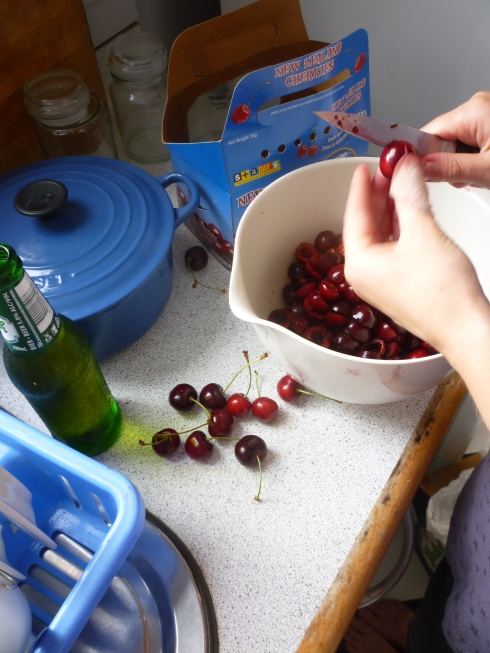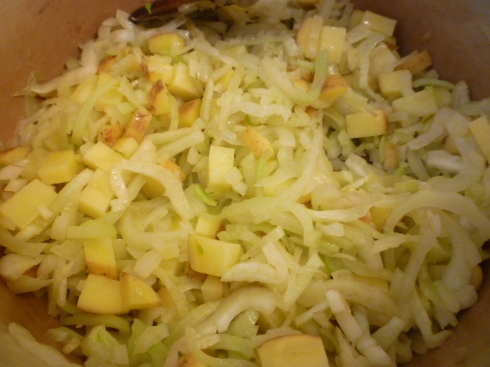Anna had told me how she’d always wanted to make Elizabeth David’s ‘Maiale al Latte’ — published in 1954 and found in the ‘best of’ collection South Wind through the Kitchen. Since I had the Les Halles version on my horizon and we were both at a loose end on Christmas Day, we somewhat inappropriately made this pork and milk dish the plat du jour. We also made what appeared to be a fairly successful clafoutis.
For the pork we let Anthony and Elizabeth go wild in the kitchen together. Undoubtedly she’ll have her own clafoutis recipe too but there was no need to further exacerbate the already noticeable tension between the two.

“I can actually taste the ONE clove in the sauce.”
I’m skipping ahead here — to the eating part — but it was then that I realised that nowhere in either recipe does it request this ingredient — unless you count my skim reading of ‘clove of garlic’ in Elizabeth’s recipe.

Back to the prep. Pitting out 675g of cherries and macerating them in Kirsch for an hour, meanwhile removing the skin from the pork — a nasty and difficult task — then binding it up. The reason I didn’t initially question the clove was the absurdity/subtlety of the other aromatics Elizabeth demands: “Stick a clove of garlic inside the rolled meat, together with 3 or 4 coriander seeds and a little marjoram, basil or fennel”. I read this as ‘blindly fumble about your herb rack and fling in a pinch of whatever — the Joneses won’t know the difference’.

Empty cherries and liquid into the eggy clafoutis mix. 6 eggs and 112g each sugar and flour, some vanilla essence, maybe some other stuff — go and buy the book already. We didn’t have a freaking scientific-grade weighing device, so there could easily have been 117g in there.
We had a lively debate about whether it would be a good idea to refrigerate the buttered baking tray before use as instructed. Would this help at all or just warp the tray? I pointed to Davy’s sticky clafoutis experience. We then moved on to discussing the meaning of finely chopped (minced vs a cubed julienne) carrot. I’ve been reading Bill Buford’s Heat, where the author apprentices himself to Chef Mario Batali. The nomenclature may vary slightly in Italian cooking:
Evidently, there are only two ways to prepare a carrot: rough cut and fine dice. Rough cut meant slicing the carrot in half lengthwise and then — chop, chop, chop — cutting it into perfectly identical half moons (which to my eye had nothing rough about them). The nightmare was fine dice, which meant cutting every bit of the carrot into identical one-millimeter-square cubes.
Brown the meat, remove, sauté veges, add 2 cups of milk and scrape the caramelised fond/glaze into the sauce. Put the meat back in and simmer. We had to frequently turn the pork and scrape the pan. Perhaps a narrower pot would allow deeper milk and more restful cooking?

We baked the clafoutis in both a muffin tray and cast iron pan. Neither stuck too badly and the little ones were super tasty. The larger one looked great and got sent off to centre stage the following day at an actual (post) Christmas dinner — possibly the most formal reception my cooking has ever received!

We had to hold Elizabeth back and hide the knives from Anthony when it came whether the sauce should be strained. He won, but we served the now creamy strained and stuck-together-with-milk-solids veges as a condiment.
The pork was tender and the sauce perfect, especially with the bread-sauceyness flavour from the clove. I highly recommend this addition. All very nicely offset by an apple and fennel salad and mashed potato.



















